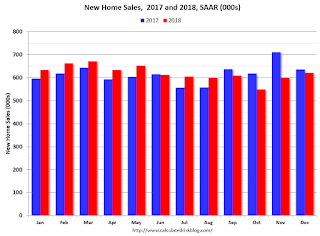by Calculated Risk on 3/05/2019 01:18:00 PM
Tuesday, March 05, 2019
A few Comments on December New Home Sales
First, this report was for December; the January report will be released on March 14th.
New home sales for December were reported at 621,000 on a seasonally adjusted annual rate basis (SAAR). This was above the consensus forecast, however the three previous months were revised down.
Even with the weakness at the end of 2018, sales increased 1.5% in 2018 compared to 2017. I expect sales to be around the same level in 2019 as in 2018 (not fall off a cliff), and my guess is we haven't seen the peak of this cycle yet.
On Inventory: Months of inventory is now above the top of the normal range, however the number of units completed and under construction is still somewhat low. Inventory will be something to watch very closely.
Earlier: New Home Sales increased to 621,000 Annual Rate in December.

This graph shows new home sales for 2017 and 2018 by month (Seasonally Adjusted Annual Rate).
The comparison for November and December were difficult (sales in November 2017 were especially strong).
And here is another update to the "distressing gap" graph that I first started posting a number of years ago to show the emerging gap caused by distressed sales. Now I'm looking for the gap to close over the next several years.
 The "distressing gap" graph shows existing home sales (left axis) through January and new home sales (right axis) through December 2018. This graph starts in 1994, but the relationship had been fairly steady back to the '60s.
The "distressing gap" graph shows existing home sales (left axis) through January and new home sales (right axis) through December 2018. This graph starts in 1994, but the relationship had been fairly steady back to the '60s. Following the housing bubble and bust, the "distressing gap" appeared mostly because of distressed sales. The gap has persisted even though distressed sales are down significantly, since new home builders focused on more expensive homes.
I still expect this gap to slowly close. However, this assumes that the builders will offer some smaller, less expensive homes. If not, then the gap will persist.
However, this assumes that the builders will offer some smaller, less expensive homes. If not, then the gap will persist.
 Another way to look at this is a ratio of existing to new home sales.
Another way to look at this is a ratio of existing to new home sales.This ratio was fairly stable from 1994 through 2006, and then the flood of distressed sales kept the number of existing home sales elevated and depressed new home sales. (Note: This ratio was fairly stable back to the early '70s, but I only have annual data for the earlier years).
In general the ratio has been trending down since the housing bust, and this ratio will probably continue to trend down over the next few years.
Note: Existing home sales are counted when transactions are closed, and new home sales are counted when contracts are signed. So the timing of sales is different.


